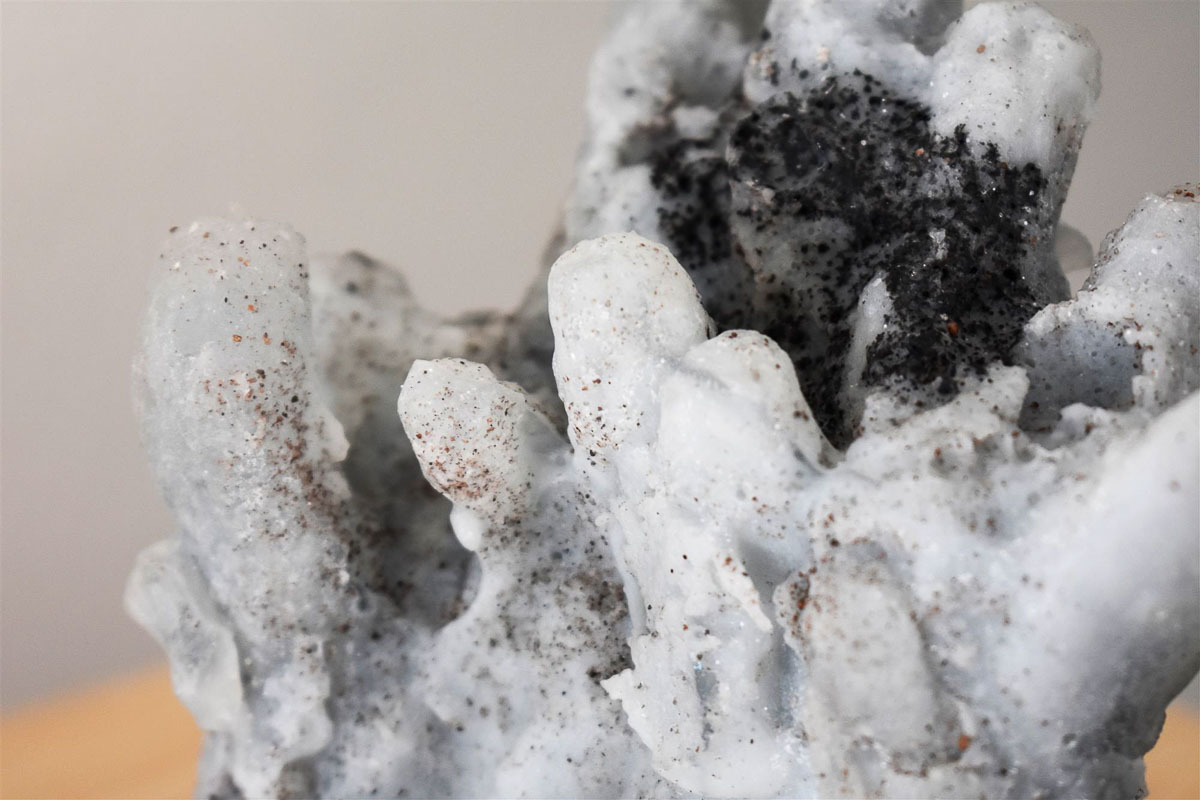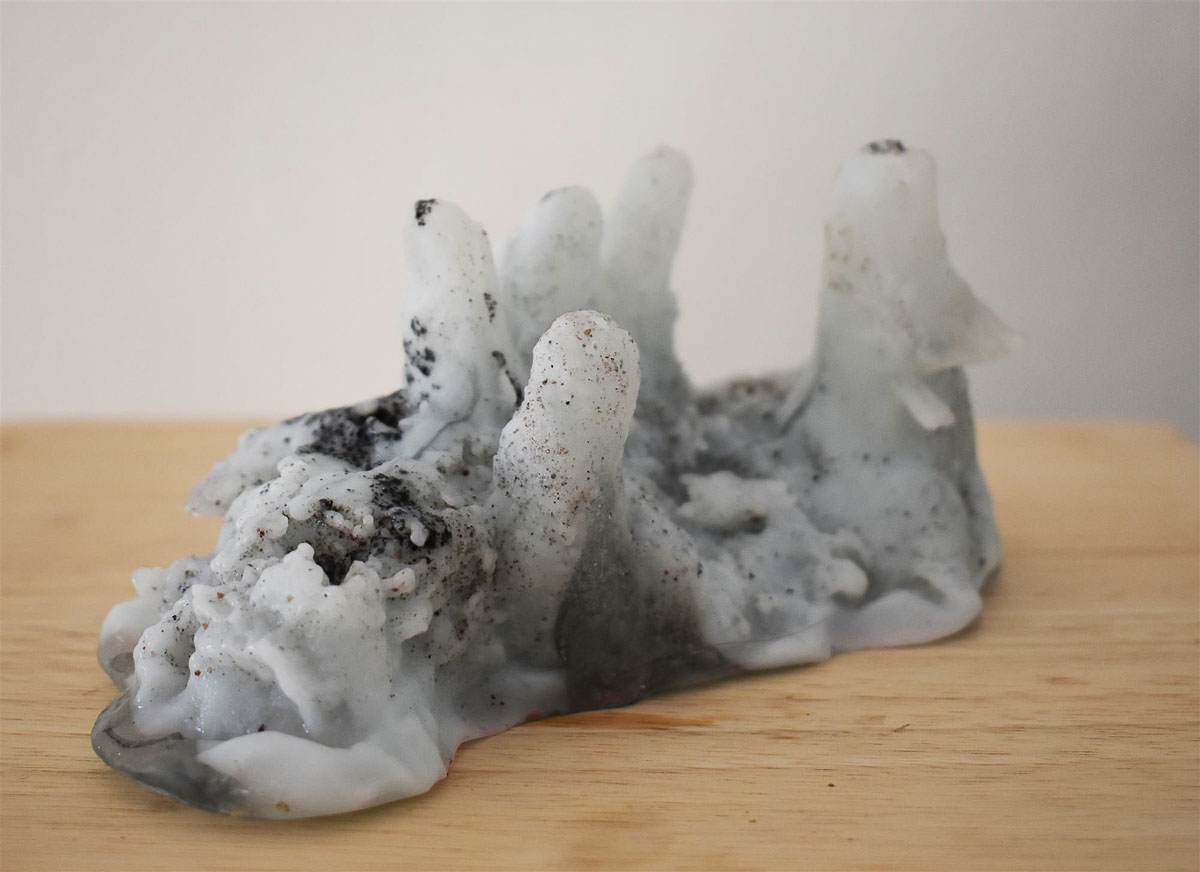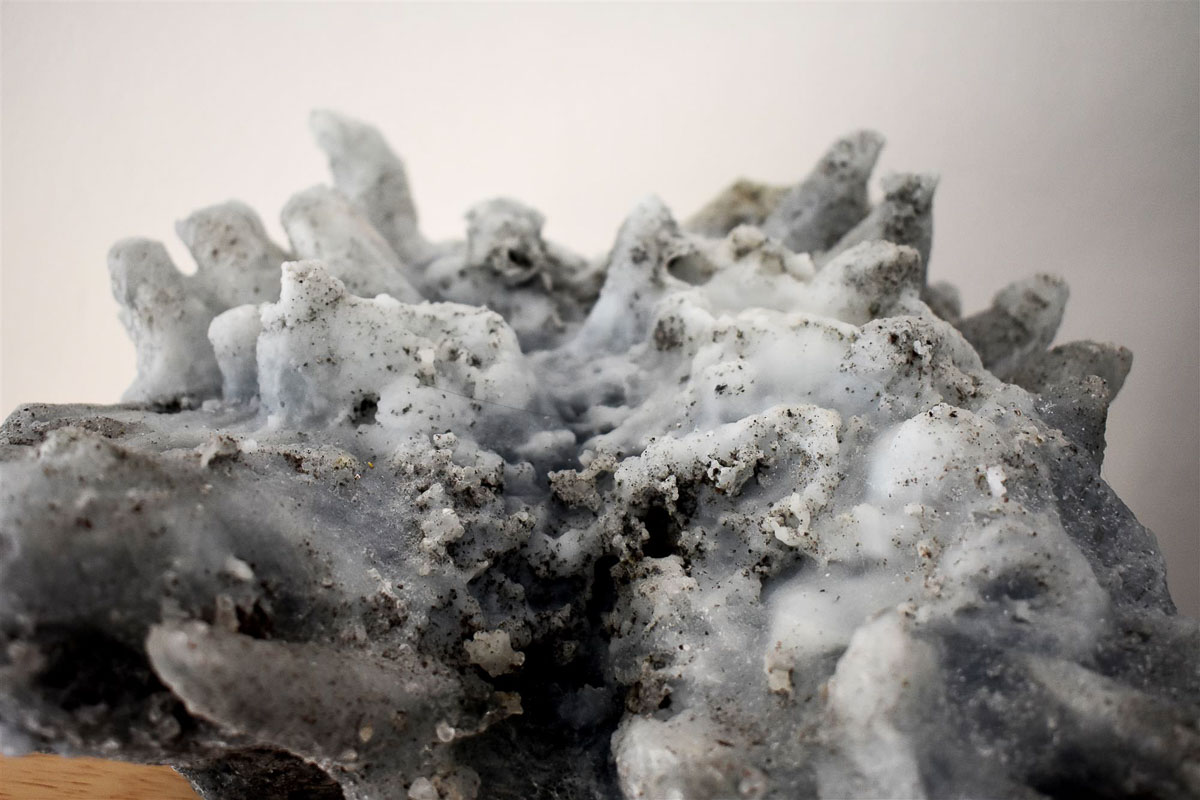For the StateoftheART Gallery Award 2021, we asked artists to find ways to engage with the reality of climate crisis and its impact on their own community; to create work to inspire and encourage societal change. The 10 finalists were chosen from more than 600 submissions from across South Africa, with the judges scoring the artists on the creativity, originality, and technical skill of their entries to this year's Award theme ‘On The Brink, Visualising Climate Change’.
The work of the shortlisted artists will go on show in a special exhibition at StateoftheART’s Cape Town gallery from 16 - 30 October 2021, and the winner announced at the Award Ceremony on 16 October 2021. The winner will receive a R40 000 cash prize and a solo exhibition with the gallery in 2022.
We asked the top ten Gallery Award Finalists some questions to help you get to know them before the Finalists Exhibition in October.
Learn more about the StateoftheART Gallery Award here>>
 "Diminished Reef I" by Liesl Roos. Reactive and recycled Bullseye glass, silver foil, sand, 16 x 17 x 10 cm
"Diminished Reef I" by Liesl Roos. Reactive and recycled Bullseye glass, silver foil, sand, 16 x 17 x 10 cm
Liesl Roos:
'In my work, I explore a personal experience of living within a changed and changing landscape. It is an exploration of our entanglement, interconnectedness, and interdependence with a world filled with ecosystems, lifeforms, and different agentive bodies.
My work reflects on new materialism and the agency that all types of bodies possess. Human and nonhuman bodies both possess the capacity to form networks with other bodies and produce effects. Nonhuman bodies, organic and synthetic, are equally involved in creating the environment. Realising the agency of all matter to alter environmental conditions, should cultivate a more attentive attitude toward different bodies.'
1. Tell us about yourself. Where are you from, and where do you currently live?My name is Liesl and for most of my life I have lived in sunny Pretoria. I am 28 years old and I am an emerging visual artist. I studied Fine Arts at the Tshwane University of Technology and completed my BTech and MTech degrees with cum laude. From 2017 to 2018 I had the opportunity to study at the Gerrit Rietveld Academy in Amsterdam at the Large Glass Department, through an independently organised exchange, which had a great impact on my conceptual process. I have had the opportunity to take part in numerous collective exhibitions from 2013 to 2020 held in Pretoria, Johannesburg, Krugersdorp, Potchefstroom, Amsterdam, Nida and Nexø. I have exhibited at the Nirox Sculpture Park, the Aardklop National Arts Festival, the Thami Mnyele Fine Arts Award, Modern Art Projects, the Stedelijk museum and other exhibition locations. I have been accepted into a master program in Belgium at PXL mad for 2021-2022 and have been awarded with a Master Mind scholarship from the Flemish government. Because of this opportunity, I have just moved to Belgium and will start my master study end of September 2021. My work focuses on human interaction with the environment and the effect we as a species have on the environment.
2. How did you learn about the Award and what made you want to enter?I became aware of the StateoftheART Gallery Award Prize through social media. The competition’s theme this year coincided with my practice and made me want to convey my message through this platform. For me ecological concerns are the greatest issue that our generation faces. We will not be able to continue to live on a planet that we are poisoning. I hope that through this platform my work will reach many people and that the artists participating can initiate change in South Africa.
3. Tell us about where you make your work.My studio where I have been practicing the last years was set up in my family home in Pretoria. Our home was built by my late father, and for me, the house held a close connection to him and made me want to stay for many years. My studio is spilt into two sections: Inside I have my glass kiln where I fire my sculptures, and outside I have a section to work on prototypes and mould making. Next to my workplace, lies a section of the Magaliesberg mountain range, which always made me feel close to nature. Small mammals like rock hyrax live there and the sound of many birds can be heard throughout the day.

Liesl Roos in studio.
4. What is your key inspiration as an artist? My key inspiration is ecosystems, the harmonious structures in which the environment coexists without depleting another. On the contrary each individual or component of the system is dependent on the other for continued equilibrium. Theorists such as Jane Bennett and her book Vibrant Matter had a big influence on me and the way I view things. Realising the interdependence in nature and our severe effect on it, made me want to advocate for developing different systems, so that we could coexist more harmoniously with the environment.
5. Do you have any rituals or habits involving your art-making that you can tell us about?I see my practice as a ritual in itself. A way of being completely present. Creating for me is therefore part of an awareness practice, similar to meditation.
6. How does your work convey the threat that climate change poses to our planet and country?Coral health may seem like a faraway issue, however reefs provide food and habitats for millions of species. Without coral reefs, the foundation for ocean health will disappear. Coral bleaching has continued to increase over the past years due to an increase in ocean temperatures, causing the water to become more acidic and uninhabitable for corals. As we are approaching more tipping points in the natural world, where systems and structures reach a critical point of leaving safe and predictable rhythms, the earth becomes immensely volatile.
7. How is your work relevant in a South African context? The important issue that needs to be understood about climate change is that natural systems of the planet are interdependent. An imbalance in one system has far reaching implications. The ocean controls the weather, the ocean controls the climate, and the ocean absorbs CO2 from the atmosphere. Without a healthy ocean we do not have a healthy planet. Corals are the foundation species of the ocean and support millions of other species, including humans, which depend on them for food and habitation. Without reefs many species will disappear and a catastrophic imbalance will occur that we cannot fathom yet.

"Diminished Reef III" by Liesl Roos. Reactive and recycled Bullseye glass, silver foil, sand, 21 x 11 x 12 cm
8. What do you think is the most urgent action required to tackle climate change in South Africa?I feel that it is very important for South Africa to start focusing on renewable energy. The country needs to make radical changes. Secondly plastic production should be taxed, limited or ideally stopped, however I do not think that it is likely to happen. Individuals can make changes to what they buy but I believed that the companies producing the products should be held responsible. Plastics end up in the ocean and increase the likely hood of corals to become diseased by eighty nine percent when covered by them. The focus has to shift to biodegradable packaging if we want to save habitats and species.
9. Which South African artists, organisations or environmental activists do you find inspirational at the moment and why?I find companies in South Africa like The Re-use store inspirational because they are focused on sustainability and offer products the can be reused and recycled. Companies like this give people the possibility to buy personal care items that are not made from plastic and don’t need to end up in the trash after a single use.
10. How do you feel about the upcoming group exhibition and the other shortlisted finalists’ works? I am extremely excited about the upcoming exhibition and to have been considered for the prize. I am grateful to exhibit my work alongside my fellow peers. I find Curb Beach Plastic’s work really inspirational because she is making a real difference in her community and for the environment. Sylvester and I have exhibited together at the Nirox sculpture park for a group exhibition previously, and I find his process very interesting as I share a similar process, in terms of creating my prototypes through sand casting, although I have been working with wax instead of ceramic slip. Casting with slip is a process I am very eager to work with and have been exploring recently.

"Diminished Reef II" by Liesl Roos. Reactive and recycled Bullseye glass, silver foil, sand, 24 x 13x 25 cm
11. What do you think of the StateoftheART Gallery Award as a platform for emerging artists in South Africa?The StateoftheArt Gallery Award Prize gives emerging artists the opportunity to express their voice and reach people across South Africa with their message. I am very thankful for the platform and their consideration of my work as well as the care they have shown for the environment.
12. If you win the Gallery Award, tell us about what you have in mind for your solo exhibition in 2022?Concept: Ecology and the Anthropocene explored through a sculptural practiceIf I were to win the prize I would like to use the opportunity to create a body of work that consists of sculptural objects. I would like these pieces to be sellable works that people would want to have in their home. It excites me to think of the possibility to share my message with others in this way, and that the work could serve as a daily reminder of our interdependence with the natural world. I would like these objects to remind people of their place and interaction with the environment they exist in. I would develop glass and ceramic pieces, created through sandcasting and mould making processes, which would combine natural formations with human like elements. These sculptures would explore my personal experience of living in a changed and changing landscape. Although they would come from a personal place, I would like the viewer to have glimpses of recognisable shapes that could evoke a personal reaction within them. I would focus on recycling materials used during the development of the work, such as making ludo to reuse for moulds, generated from any moulds made, and using recyclable materials such as sand, clay, and glass.
13. Finally, tell us something surprising about yourself.This year I entered an installation for the Sasol New Signatures competition. I was torn about the decision to enter but in the end I felt that it was very important to share my message, specifically on this platform. I hope that though discussing environmental concern on platforms such as Sasol, artists can initiate real change in South Africa. My work was accepted during the first judging round and will be exhibited at the Pretoria Art Museum later this year.

